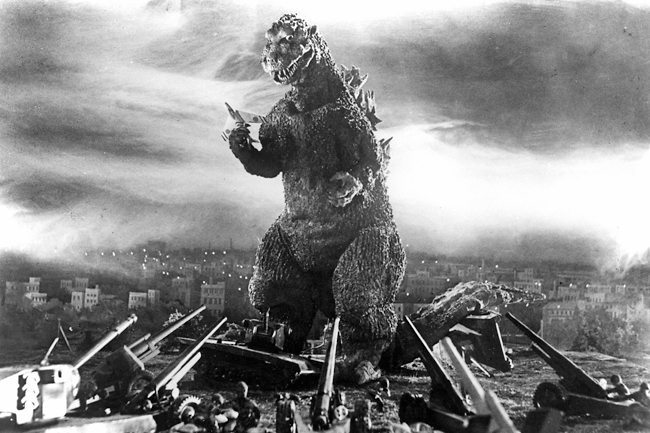AP – Nobel Peace Prize has been awarded to Nihon Hidankyo, the Japan Confederation of A and H-bomb Sufferers Organizations.
Many of these witnesses have spent their lives warning of the dangers of nuclear war – but initially, much of the world didn’t want to hear it. “The fates of those who survived the infernos of Hiroshima and Nagasaki were long concealed and neglected,” the Nobel committee noted in its announcement.
Local groups of nuclear survivors created Nihon Hidankyo in 1956 to fight back against this erasure.
Around the same time that Nihon Hidankyo was formed, Japan produced another warning: a towering monster who topples Tokyo with blasts of irradiated breath.
The 1954 film Godzilla launched a franchise that has been warning viewers to take better care of the Earth for the past 70 years.
We study popular Japanese media and business ethics and sustainability, but we found a common interest in Godzilla after the 2011 earthquake, tsunami and meltdown at Japan’s Fukushima Daiichi nuclear plant.
In our view, these films convey a vital message about Earth’s creeping environmental catastrophe. Few survivors are left to warn humanity about the effects of nuclear weapons, but Godzilla remains eternal.


INTO THE ATOMIC AGE
Godzilla is full of deep social debates, complex characters and cutting-edge special effects for its time. Much of the film involves characters discussing their responsibilities – to each other, to society and to the environment.
This seriousness, like the film itself, was practically buried outside of Japan by an alter ego, 1956’s Godzilla, King of the Monsters! American licensors cut the 1954 film apart, removed slow scenes, shot new footage featuring Canadian actor Raymond Burr, spliced it all together and dubbed their creation in English with an action-oriented script they wrote themselves.
This version was what people outside of Japan knew as Godzilla until the Japanese film was released internationally for its 50th anniversary in 2004.
FROM RADIATION TO POLLUTION
While King of the Monsters! travelled the world, Godzilla spawned dozens of Japanese sequels and spin-offs.
Godzilla slowly morphed from a murderous monster into a monstrous defender of humanity in the Japanese films, which was also reflected in the later US-made films.
In 1971, a new, younger creative team tried to define Godzilla for a new era with Godzilla vs Hedorah. Director Yoshimitsu Banno joined the movie’s crew while he was promoting a recently completed documentary about natural disasters. That experience inspired him to redirect Godzilla from nuclear issues to pollution.
Godzilla vs Hedorah is about Godzilla’s battles against Hedorah, a crash-landed alien that grows to monstrous size by feeding on toxic sludge and other forms of pollution.
The film opens with a woman singing jazzily about environmental apocalypse as young people dance with abandon in an underground club.
This combination of hopelessness and hedonism continues in an uneven film that includes an extended shot of an oil slick-covered kitten.
After Godzilla defeats Hedorah at the end of the film, it pulls a handful of toxic sludge out of Hedorah’s torso, gazes at the sludge, then turns to stare at its human spectators – both those onscreen and the film’s audience. The message is clear: Don’t just lazily sing about imminent doom – shape up and do something.
Godzilla vs Hedorah bombed at the box office but became a cult hit over time. Its positioning of Godzilla between Earth and those who would harm it resonates today in two separate Godzilla franchises.
The 2011 Fukushima disaster has now become part of the Japanese people’s collective memory.
Clean-up and decommissioning of the damaged nuclear plant continues, amid controversies around ongoing releases of radioactive water used to cool the plant.
A MELTDOWN OF PUBLIC TRUST
Before Fukushima, Japan derived one-third of its electricity from nuclear power. Public attitudes toward nuclear energy hardened after the disaster, especially as investigations showed that regulators had underestimated risks at the site.
Although Japan needs to import about 90 per cent of the energy it uses, today over 70 per cent of the public opposes nuclear power. The first Japanese Godzilla film released after the Fukushima disaster, Shin Godzilla (2016), reboots the franchise in a contemporary Japan with a new type of Godzilla, in an eerie echo of the damages of and governmental response to Fukushima’s triple disaster. When the Japanese government is left leaderless and in disarray following initial counterattacks on Godzilla, a Japanese government official teams up with an American special envoy to freeze the newly named Godzilla in its tracks, before a fearful world unleashes its nuclear weapons once again. Their success suggests that while national governments have an important role to play in major disasters, successful recovery requires people who are empowered to act as individuals. – Amanda Kennell




